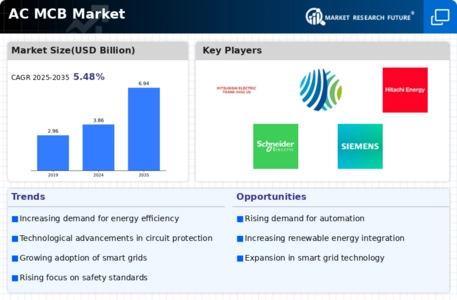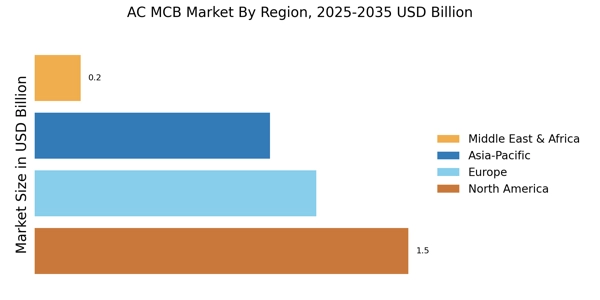Increasing Urbanization
The AC MCB Market is experiencing a notable surge due to the rapid urbanization observed in various regions. As populations migrate towards urban centers, the demand for residential and commercial buildings escalates. This trend necessitates enhanced electrical safety measures, thereby driving the need for miniature circuit breakers (MCBs). According to recent data, urban areas are projected to house approximately 68% of the world's population by 2050, which could lead to a significant increase in the installation of electrical systems. Consequently, the AC MCB Market is likely to expand as builders and developers prioritize safety and compliance with electrical standards in new constructions.
Regulatory Compliance and Standards
The AC MCB Market is significantly influenced by stringent regulatory frameworks and safety standards established by various authorities. These regulations mandate the use of reliable electrical protection devices in residential, commercial, and industrial applications. For instance, the International Electrotechnical Commission (IEC) has set forth guidelines that necessitate the installation of MCBs to prevent electrical hazards. As a result, manufacturers are compelled to innovate and produce MCBs that meet these compliance requirements. The increasing emphasis on safety and adherence to regulations is expected to propel the AC MCB Market, as stakeholders seek to mitigate risks associated with electrical failures.
Expansion of Renewable Energy Sources
The AC MCB Market is also influenced by the expansion of renewable energy sources, such as solar and wind power. As more households and businesses adopt renewable energy systems, the need for effective electrical protection becomes paramount. MCBs play a crucial role in safeguarding these systems from electrical faults and ensuring their efficient operation. The increasing installation of solar panels and wind turbines is expected to create new opportunities for the AC MCB Market, as manufacturers develop specialized MCBs tailored for renewable energy applications. This trend indicates a promising future for the industry as it aligns with the global shift towards sustainable energy solutions.
Rising Awareness of Electrical Safety
The AC MCB Market is benefiting from a growing awareness of electrical safety among consumers and businesses alike. Educational campaigns and initiatives aimed at promoting safe electrical practices have led to an increased understanding of the importance of circuit protection devices. As individuals become more informed about the risks associated with electrical faults, the demand for MCBs is expected to rise. Furthermore, industries are increasingly prioritizing safety measures to protect their assets and personnel, which further drives the AC MCB Market. This heightened awareness is likely to result in a sustained increase in MCB installations across various sectors.
Technological Advancements in Circuit Protection
The AC MCB Market is witnessing a transformation driven by technological advancements in circuit protection devices. Innovations such as digital MCBs, which offer enhanced monitoring and control features, are gaining traction among consumers. These advanced devices not only provide superior protection against overloads and short circuits but also facilitate remote management through smart home systems. The integration of Internet of Things (IoT) technology into MCBs is particularly noteworthy, as it allows for real-time data analysis and predictive maintenance. This trend is likely to attract a broader customer base, thereby stimulating growth within the AC MCB Market.

















Leave a Comment